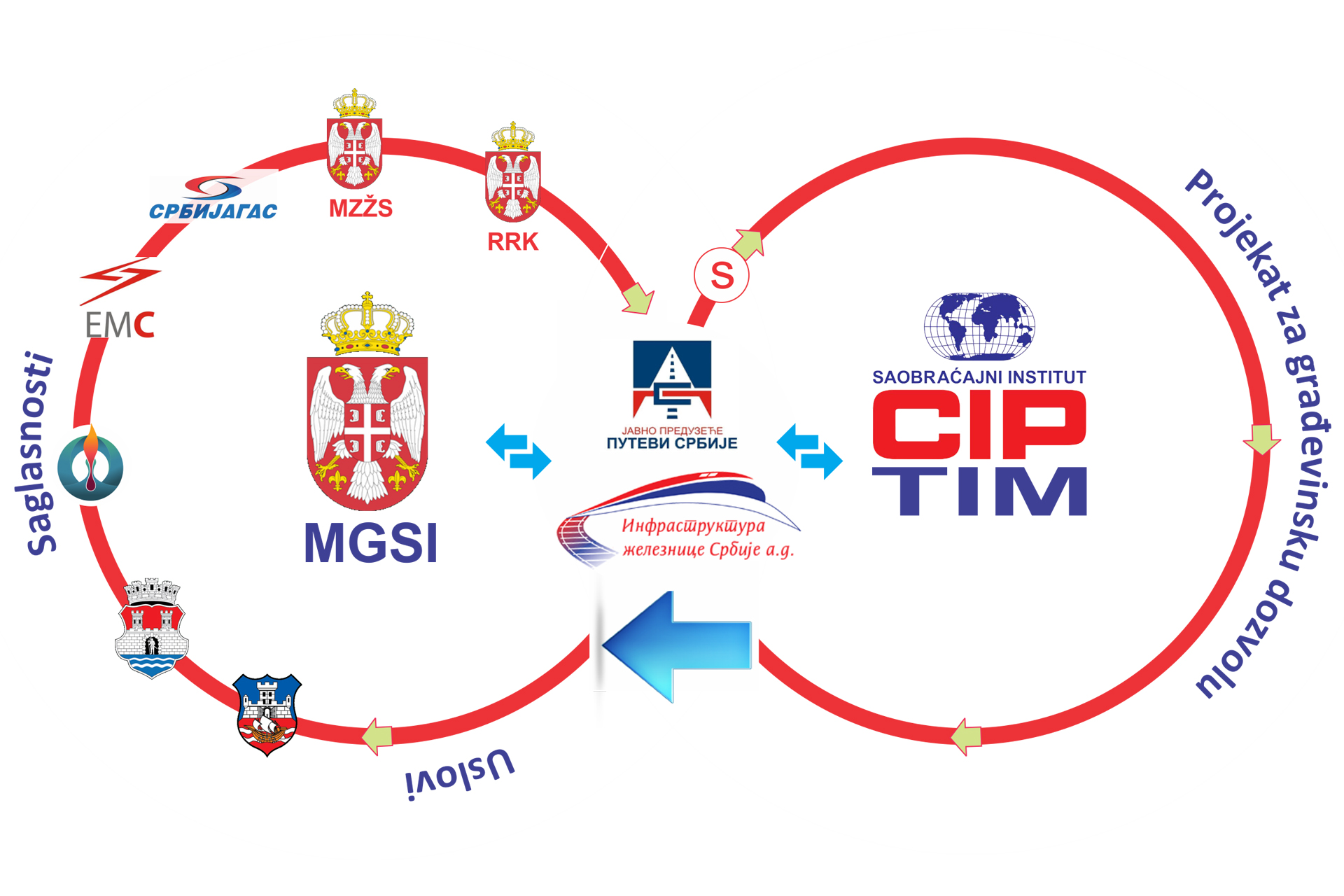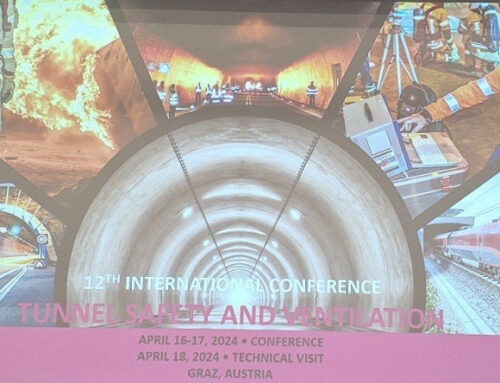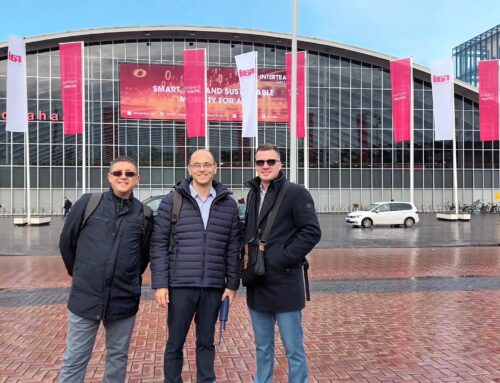The experts of Saobraćajni institut CIP held the first meeting on the preparation of the building permit design of the Belgrade bypass (Sector C) – section from Bubanj potok to Pančevo.
Apart from the CIP TEAM, the meeting was attended by mister Goran Vesić, Minister of Construction, Transport and Infrastructure with associates, and key actors from all institutions responsible for efficient project implementation (PE Roads of Serbia, Serbian Railways Infrastructure, representatives of the city of Belgrade and the city of Pančevo, etc.).
The objective of the meeting was initiation and integration of activities, definition and harmonization of design methodology, definition of time schedule and allocation of activities by key actors. Moreover, competencies of all actors were defined at the meeting, and pragmatic discussion was focused on harmonization and optimization of future technical solutions and key activities.
The importance of the Belgrade bypass completion was highlighted at the meeting, bearing in mind that Sector C is extremely significant for the city of Belgrade, the city of Pančevo and the Republic of Serbia. Upon completion of Sector C, most of traffic flows from northeast part of the region that currently pass through the city of Belgrade will be practically redirected outside the central city core.
In addition to the highway bypass, Sektor C includes the railway bypass and therefore represents an important segment in the development and completion of the Belgrade Railway Junction (BRJ), and connection of its infrastructure capacities with the Pančevo – Vršac and the Pančevo – Zrenjanin railway lines, and with the Pančevo junction infrastructure.
Upon completion of Sector C, traffic flows and transport of hazardous materials by road and railway will be redirected outside central zones of Belgrade and Pančevo.
Positive effects observed in the wider context are expected through alleviation of traffic congestion in the main street networks of Belgrade and Pančevo, thus directly making a positive impact on broader flow chart in the traffic-transport systems of both cities.
TECHNICAL DATA OF SECTOR C
ROAD INFRASTRUCTURE
THE BUBANJ POTOK – VINČA – PANČEVO highway section in Sector C is about 31 km long in total. The highway was envisaged for design speed of 130 km/h with 28.40 m wide profile (2 carriageways, each with 2 traffic lanes, 3.75 m wide, emergency lane, 2.50 m wide, 0.5 m + 0.20 m verges, central reserve, 4.0 m wide, and shoulders on both sides, 1.50 m wide each). The highway will be connected with state and local roads by 4 INTERCHANGES: BOLEČ INTERCHANGE (connection to the II-A class state road, no. 153 (Leštane – Grocka – Petrijevo – Ralja and connection to the A1 state road (Belgrade – Niš)), PANČEVO SOUTH / STARČEVO INTERCHANGE (connection with local road to Banatski Brestovac serving to connect the highway with industrial zone in Pančevo), PANČEVO – EAST INTERCHANGE (connection to the I-B class state road no. 14 (Pančevo – Kovin)) and PANČEVO – NORTH INTERCHANGE (connection to the I-B class state road no. 10 (Belgrade – Pančevo – Vršac)). The highway route also includes 2 TUNNELS (IN THE TOTAL LENGTH OF 4,009 m): BUBANJ POTOK TUNNEL (1,311 m – on the left carriageway, 1,270 m – on the right carriageway) and LEŠTANE TUNNEL (704 m – on the left carriageway, 724 m on the right carriageway). The design also envisaged 35 STRUCTURES (17 structures in the highway base, i.e., 34 bridge structures in the total length of about 3.4 km, 9 bridges at grade-separated junctions and road diversions – in the total length of 1,981 m and 9 overpasses in the total length of 1,742 m).
RAILWAY INFRASTRUCTURE
The railway bypass from existing Beli potok station on the Belgrade – Mala Krsna railway line to Srpsko selo branching-off point on the Belgrade – Pančevo – Vršac railway line is 28.8 km long. THREE NEW STATIONS: BOLEČ STATION, PANČEVO – FREIGHT STATION AND PANČEVO – RACETRACK STATION with station buildings and access roads were designed on the railway line. The railway line was planned to be a single-track line for speed of 120 km/h, electrified and provided with modern signalling-interlocking and telecommunication equipment. All crossings of the railway line with the existing and planned roads are grade-separated, so that a total of 14 structures in the total length of about 2.2 km were designed. TWO TUNNELS: BUBANJ POTOK TUNNEL (L = 1.608 m) and LEŠTANE TUNNEL (L = 915 m) with related evacuation tunnels were designed on the railway line alignment. All technical solutions are adjusted to the Belgrade bypass project, and the Bubanj potok – Vinča – Pančevo section will be designed in accordance with very demanding interoperability standards (TSI).
BRIDGE OVER THE DANUBE RIVER
The Sector C route crosses the Danube River near Vinča settlement. The plan defines that a combined road-railway bridge with full highway profile for road traffic and one track for railway traffic will be built. The bridge will be 1,807 m long in total, while the the bridge over the Danube River will be about 600 m long. It was planned that railway line will be in the central part of the bridge structure with carriageways for road traffic at outer sides. In addition, service walkways are envisaged at both sides. The position of the bridge over the Danube River was chosen based on geotechnical characteristics of the terrain, the position of the main European corridor, the locations of archaeological sites in the area of Vinča, and the construction requirements for highway and railway approach ramps. The bridge will comply with the rules for bridging international waterways, such as spacing between piers or pavement structure height.




